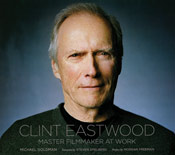(Harry N. Abrams, 238 pages, $40)
By Michael Goldman
 Over the past 40 years, Clint Eastwood has gone from being ‘The Man with No Name’ to one of the industry’s most respected filmmakers. He has garnered a reputation for dependably coming in under budget and on time, thanks in large measure to the efficiency of his production company, Malpaso. But for all of his economy, one can hardly call his work clinical as evidenced by a canon of films of undeniable luster, style, and compelling variety. Michael Goldman’s Clint Eastwood: Master Filmmaker at Work is a serious appraisal of the director’s films and his deep, emotional investment in his story and his crew.
Over the past 40 years, Clint Eastwood has gone from being ‘The Man with No Name’ to one of the industry’s most respected filmmakers. He has garnered a reputation for dependably coming in under budget and on time, thanks in large measure to the efficiency of his production company, Malpaso. But for all of his economy, one can hardly call his work clinical as evidenced by a canon of films of undeniable luster, style, and compelling variety. Michael Goldman’s Clint Eastwood: Master Filmmaker at Work is a serious appraisal of the director’s films and his deep, emotional investment in his story and his crew.
Goldman’s hearty, visually splendid book, is a weighted, and occasionally reverent, portrait of the artist through a collage of striking photographs, and original interviews—over 60 of them—with Eastwood’s closest collaborators. An intimate analysis of all 32 of Eastwood’s films, each chapter hones in on a certain aspect of Eastwood’s film aesthetic and process, often in poetic terms. Goldman proposes, for example, that Eastwood’s on-set philosophy is that of “watering the flower” and makes his case by tightly culled interviews with DPs, production designers and actors that bring us inside his directorial method. Eastwood’s tough-as-nails onscreen personality belies his nurturing, father-figure presence on set. Far from a Dirty Harry in a director’s chair, he knows when to stay out of the way, when to water, how to cultivate, and we are able to sense something of the deep fraternal respect and loyalty between director and crew. “It’s really not an auteur thing,” Eastwood tells Goldman, “it’s an ensemble.”
That ensemble lavishes the reader with rare behind-the-scenes access to the nuts-and-bolts of an Eastwood set, and Goldman fashions their collective testimony into the portrait of a master craftsman. His longtime DP Tom Stern discusses the deeply saturated palette that is the director’s hallmark and maintains that “Clint always knows what he wants. Lots of low light and shadow … [he is always] trying to make his blacks blacker.” His camera operator reveals that, so implicit is Eastwood’s trust in Stern, his “right arm,” that shots are rarely played back on a video monitor. His discordant editing choices—the quick cutting action sequences (learned from Don Siegel) against the languorous pacing of his films—are deliberate. “Editing is all about making the most out of emotional moments,” he says. And Goldman spends plenty of time detailing Eastwood’s famous efficiency on the set.
It is an easy thing to take an icon for granted, especially when it’s Clint Eastwood. But Goldman’s book is sensitive without being sentimental in bringing to the table a discussion of this artistically ambitious craftsman from the perspective of the people who have worked with him for many years.
Review written by Carley Johnson